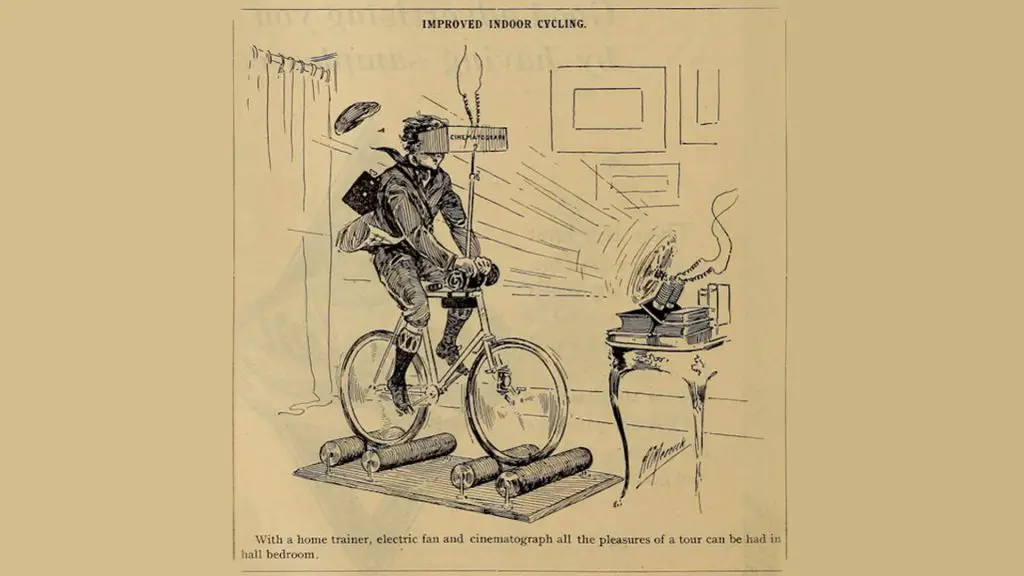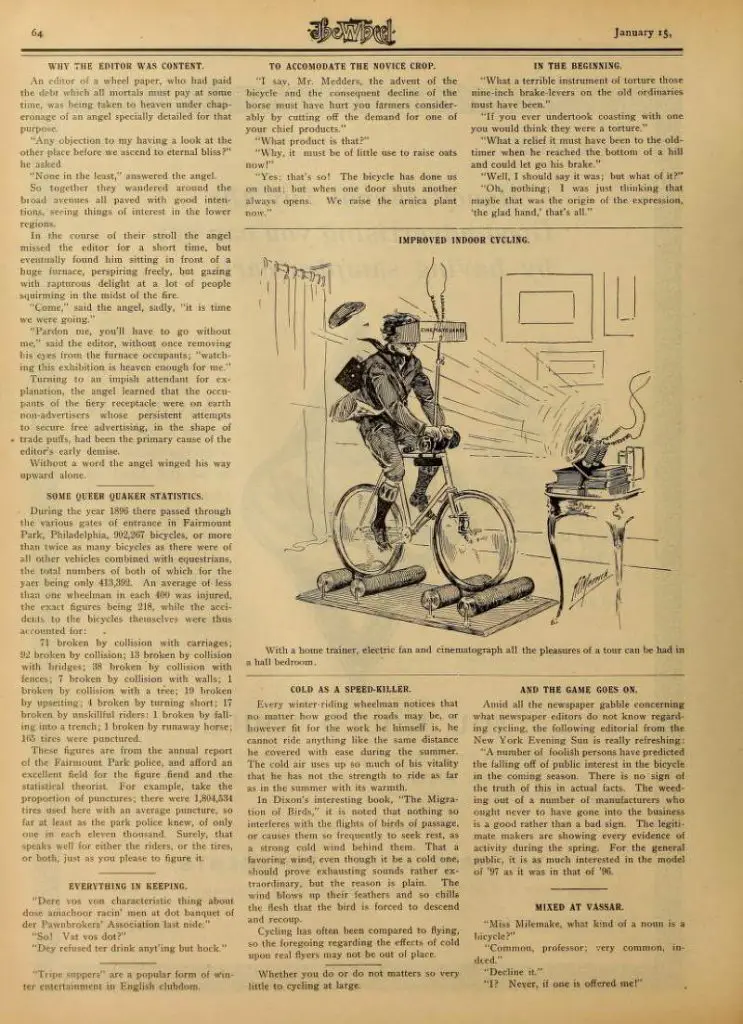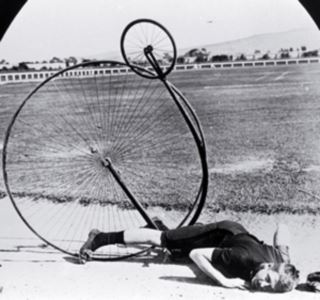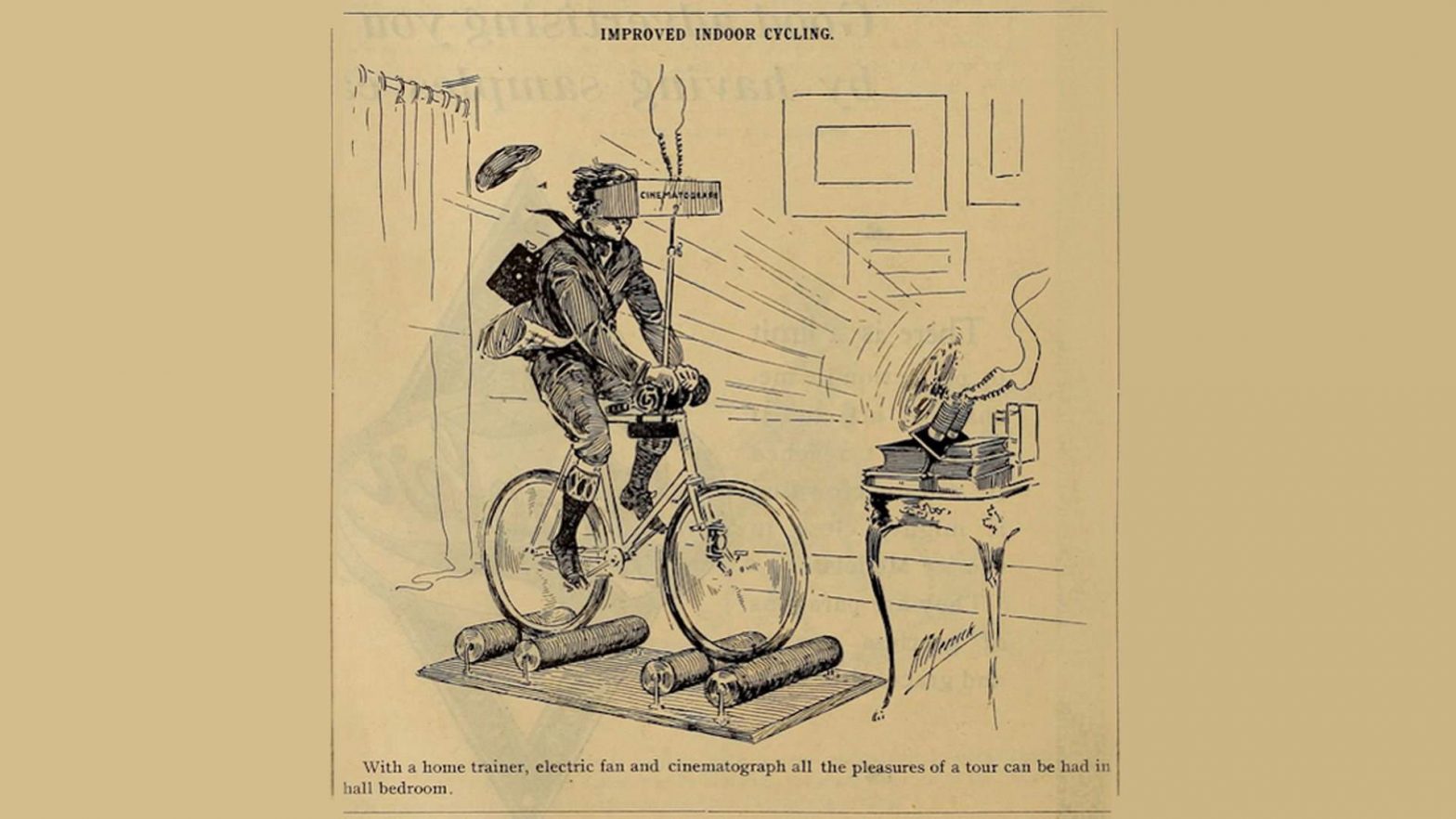It seems people were already dreaming about virtual indoor cycling training tools (like Zwift or Rouvy) for more than 130 years ago, as early as 1888. Here’s a futuristic home cycling training idea from 1888.

Virtual indoor cycling training idea from 1888
Below is some of the text from the book “The Wheel and cycling trade review”, released in 1888.
The page gives really weird statistics. First of all, there were a LOT of people were using bicycles back then, and secondly, the police were recording really weird statistics of the unimportant events, like a puncture.
Some Queer Quaker Statistics
During the year 1896, there passed through the various gates of entrance in Fairmount Park [see notes 1], Philadelphia, 902,967 bicycles, or more than twice as many bicycles as there were of all other vehicles combined with equestrians, the total numbers of both of which for the year being only 413,392. An average of less than one wheelman in each 400 was injured, the exact figures being 218, while the accidents to the bicycles themselves were thus accounted for:
- 71 broken by collision with carriages
- 92 broken by a collision
- 18 broken by collision with bridges
- 38 broken by collision with fences
- 7 broken by collision with walls
- 1 broken by collision with a tree
- 19 broken by upsetting
- 4 broken by turning short
- 17 broken by unskillful riders
- 1 broken by falling into a trench
- 1 broken by a runaway horse
- 165 tires were punctured
These figures are from the annual report of the Fairmount Park police, and afford an excellent field for the figure fiend and the statistical theorist. For example, take the proportion of punctures: there were 1,804,534 tires used here with an average puncture, so far at least as the park police knew, of only one in each eleven thousand. Surely, that speaks well for either the riders, or the tires, or both, just as you please to figure it.
Everything in keeping
“Dere vos von characteristic thing about dose amachoor racin’ men at dot banquet of der Pawnbrokers’ Association last nide”. [A thick Philadelphian? accent – he is probably saying “There was one characteristic thing about those amateur racing men at that banquet of the Pawnbrokers’ Association last night”]
“So! Vat vos dot?” [“So! What was that?”]
“Day refused ter drink anyt’ing but hock.” [“They refused to drink anything but hock.” – “Hock” is a British term for German white wine; sometimes it refers to white wine from the Rhine region (specifically Riesling) and sometimes to all German white wine.”]
To accommodate the novice crop.
“I say, Mr. Medders, the advent of the bicycle and the consequent decline of the horse must have hurt you farmers considerably by cutting off the demand for one of your chief products.”
“What product is that?”
“Why, it must be of little use to raise oats now!”
“Yes; that’s so! The bicycle has done us on that; but when one door shuts another always opens. We raise the arnica plant now.”
Cold as a speed-killer

Every winter-riding wheelman notices that no matter how good the roads maybe, or however fit for the work he himself is, he cannot ride anything like the same distance he covered with ease during the summer. The cold air uses up so much of his vitality that he has not the strength to ride as far as in the summer with its warmth.
In Dixon’s interesting book, “The Migration of Birds”, it is noted that nothing so interferes with the flights of birds of passage, or causes them so frequently to seek rest, as a strong cold wind behind them. That a favoring wind, even though it be a cold one, should prove exhausting sounds rather extraordinary, but the reason is plain. The wind blows up their feathers and so chills the flesh that the bird is forced to descend and recoup.
Cycling has often been compared to flying, so the foregoing regarding the effects of cold upon real flyers may not be out of place.
In the beginning
“What a terrible instrument of torture those nine-inch brake-levers on the old ordinaries [see notes 2] must have been.”
“If you ever undertook coasting with one you would think they were a torture.”
“What a relief it must have been to the old-timer when he reached the bottom of a hill and could let go his brake.”
“Well, I should say it was; but what of it?”
“Oh, nothing; I was just thinking that maybe that was the origin of the expression, ‘the glad hand’, that’s all.
And the game goes on
Amid all the newspaper gabble concerning what newspaper editors do not know regarding cycling, the following editorial from the New York Evening Sun is really refreshing:
“A number of foolish persons have predicted the falling off of public interest in the bicycle in the coming season. There is no sign of the truth of this in actual facts. The weeding out of a number of manufacturers who ought never to have gone into the business is a good rather than a bad sign. The legitimate makers are showing every evidence of activity during the spring. For the general public, it is as much interested in the model of ’97 as it was in that of ’96.”
The Wheel and cycling trade review
- Publisher: Wheel and Cycling Trade Review
- Published: 1888
- Subject(s): History and Culture
- No Copyright – United States
- Read the full book here

Notes
- Fairmount is a neighborhood within Lower North Philadelphia, United States.
- The penny-farthing, also known as a high wheel, high wheeler, or ordinary, was the first machine to be called a “bicycle”. It was popular in the 1870s and 1880s, with its large front wheel providing high speeds (owing to it traveling a large distance for every rotation of the legs) and comfort (the large wheel provides greater shock absorption).

Sources
- Penny-farthing on Wikipedia
- Top 18 fastest Paris-Roubaix editions - April 7, 2024
- Col de Tourmalet [Amazing photo from the 1953 Tour de France] - January 11, 2024
- Bernard Hinault and Francesco Moser, 1981 Paris-Roubaix - December 8, 2023

